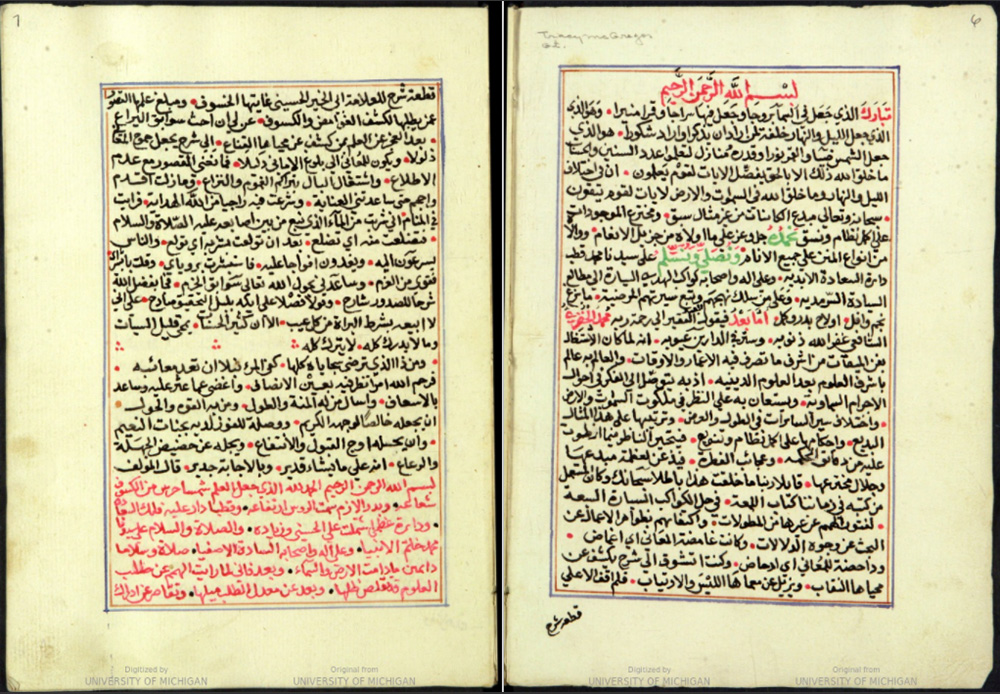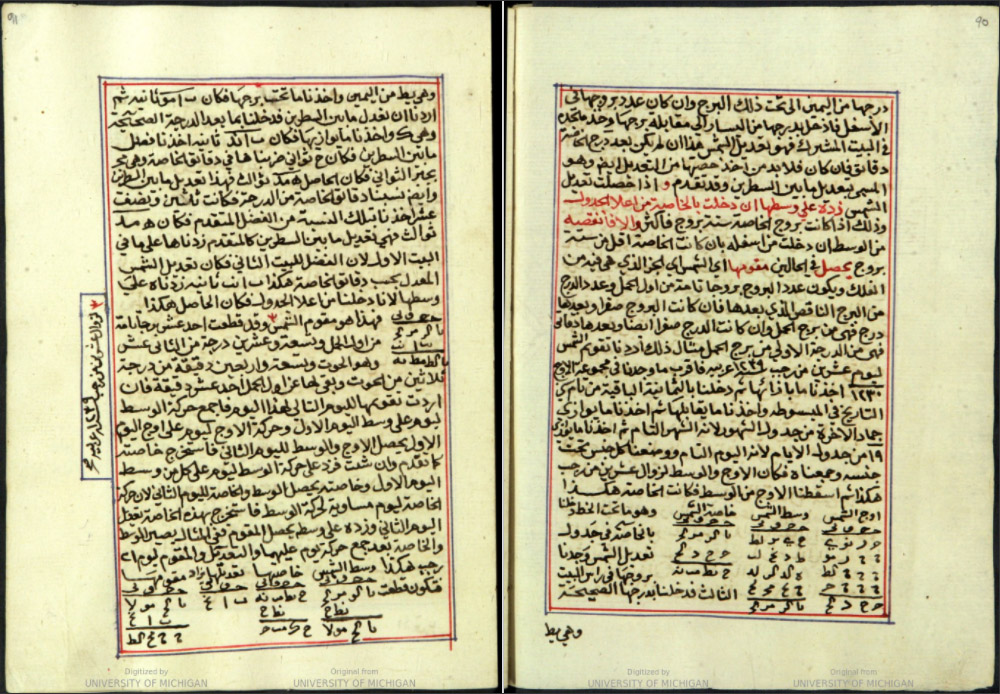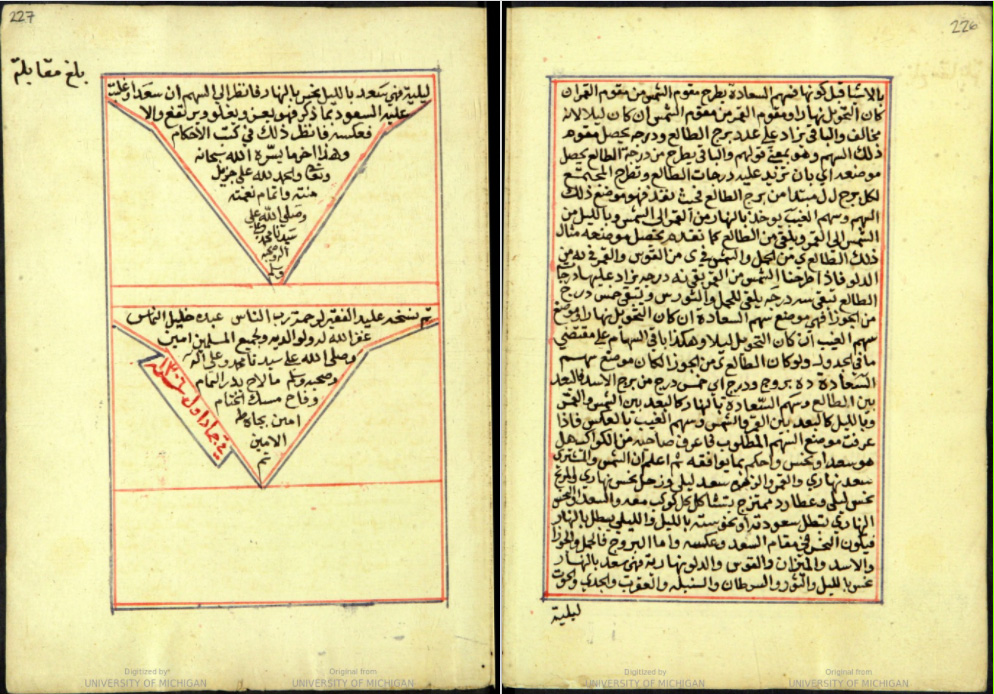Study and Practice: Muḥammad al-Khuḍarī al-Dimyāṭī (d.1870/1)
19th century Cairo

- شرح العلامة الحبر الفهامة الشيخ الخضري على اللمعة في حل الكواكب السيارة السبعة
- محمد الخضري الدمياطي
- Sharḥ al-ʻallāmah al-ḥibr al-fahhāmah al-shaykh al-Khuḍarī ʻalá al-Lumʻah fī ḥall al-kawākib al-sayyārah al-sabʻah.
- Muḥammad al-Khuḍarī al-Dimyāṭī (d.1870/1).
- Copied most likely in Cairo, 1889 by Khalīl al-Naḥḥās.
- Arabic.
- Manuscript codex on watermarked laid paper.
- Isl. Ms. 722, p.6/7.

- شرح العلامة الحبر الفهامة الشيخ الخضري على اللمعة في حل الكواكب السيارة السبعة
- محمد الخضري الدمياطي
- Sharḥ al-ʻallāmah al-ḥibr al-fahhāmah al-shaykh al-Khuḍarī ʻalá al-Lumʻah fī ḥall al-kawākib al-sayyārah al-sabʻah.
- Muḥammad al-Khuḍarī al-Dimyāṭī (d.1870/1).
- Copied most likely in Cairo, 1889 by Khalīl al-Naḥḥās.
- Arabic.
- Manuscript codex on watermarked laid paper.
- Isl. Ms. 722, p.90/91.

- شرح العلامة الحبر الفهامة الشيخ الخضري على اللمعة في حل الكواكب السيارة السبعة
- محمد الخضري الدمياطي
- Sharḥ al-ʻallāmah al-ḥibr al-fahhāmah al-shaykh al-Khuḍarī ʻalá al-Lumʻah fī ḥall al-kawākib al-sayyārah al-sabʻah.
- Muḥammad al-Khuḍarī al-Dimyāṭī (d.1870/1).
- Copied most likely in Cairo, 1889 by Khalīl al-Naḥḥās.
- Arabic.
- Manuscript codex on watermarked laid paper.
- Isl. Ms. 722, p.226/227.
This work is a commentary (sharḥ) by Muḥammad al-Khuḍarī al-Dimyāṭī (d.1870/1) on an astronomical handbook (zīj) entitled al-Lumʻah fī ḥall al-kawākib al-sabʻah (The Brilliancy of the Solution of the Seven Planets) by the 15th century Egyptian astronomer Shihāb al-Dīn Aḥmad Ibn Ghulām Allāh al-Kawm al-Rīshī (d.1432).
As such, the text provides to the practicing astronomer, astrologer or timekeeper (muwaqqit) a set of tables and instructions for setting a calendar and converting between calendars, measuring time and computing planetary and stellar positions, appearances and eclipses in a particular locale, in this case Cairo.
Muḥammad al-Khuḍarī was born in Damietta and went to Cairo at the age of seventeen to train as a scholar in the traditional circles of learning at al-Azhar. For him and other Muslim scholars, astronomy belonged to the array of sciences that comprised what it meant to be a scholar, though its study was typically undertaken outside the madrasah (traditional Islamic educational institution) in the homes of particular teachers. For al-Khuḍarī and other practitioners of what Daniel Stolz has called “scholarly astronomy,” scientific practice in Late Ottoman Egypt derived conventions and significance from a broader training in Islamic discursive traditions, but extended beyond Islamic ritual and theology to the study of dates (chronology), the study of measuring time (horology) and the interpretation of the divisions of time (astrology). Indeed most readers of al-Khuḍarī’s widely circulated commentary on Ibn Ghulām Allāh’s astronomical handbook found its significance in light of their need for astronomical knowledge to navigate multiple calendars and make astrological determinations. (Stolz 2018 p16, 34 ff)
In his commentary, al-Khuḍarī focuses on the interests of students, explaining difficult passages and providing supplementary detail found in other texts. For beginning students, he offers extensive definitions and stages for progressing through lengthy mathematical procedures. For more advanced students, he relies on more recent sources — including his own expertise — to correct and update the handbook being commented upon while still respecting its structure and authority. He also compares the handbook’s procedures — based on those of Ibn al-Shāṭir (d.1375/6)— with those of the later Zīj-i Sulṭānī compiled at Samarqand under the amīr Ulugh Beg (d.1449). Among other questions, the two famous handbooks disagree on determining the times of eclipses, and al-Khuḍarī invites his readers to compare their accuracy based on observed phenomena — running the calculations for predictions involving a contemporary date / location to see which procedure was more accurate. (Stolz 2018 p55-60)
The preparation of commentary (and supercommentary = ḥāshiyah, also referred to as a gloss) was a respected and important means of study and teaching in Islamic scholarly traditions, including astronomy. Commentary offered a site for debate and engagement with new ideas while also preserving the broader discursive tradition.
In this manuscript, the text of the work being commented upon is provided in red ink to set it apart from the text of the commentary, which appears in black. Marginal corrections, addressing omissions and other errors that arose in the process of copying, are provided in the margins, with signes-de-renvoi pointing back to where the omitted text should have appeared.
While al-Khuḍarī’s treatise compares the procedures of earlier handbooks and discusses skilled calculation using tables, it is notably silent on another topic — the motion of the earth in an orbit around the sun. He makes no mention of Copernicus, Kepler, Laplace or even the possibility of heliocentricity though he surely had encountered the idea. Stolz proposes that al-Khuḍarī’s silence suggests something more interesting than simple doubt — instead, he may not have thought it relevant enough to mention. Heliocentric models had been circulating in the region since the 17th century and al-Khuḍarī had access to these through his teacher Ḥasan al-ʻAṭṭār (d.1834/5). He simply may not have deemed this topic of sufficient practical interest in the absence of tools to link a heliocentric model with predictive techniques. After all, his treatise was not a theoretical one in the field of ʿilm al-hayʾah (“science of the configuration” of the universe) and he and his contemporaries seemed to have far greater interest in the utility of astronomy for negotiating apparent phenomena for the purposes of measuring and interpreting the passage of time through calendars, timekeeping and astrology. (Stolz 2018 p65-75)
Select Bibliography
- Isl. Ms. 722 Online catalogue record (R Dougherty).
- Stolz, Daniel. 2018. The Lighthouse and the Observatory: Islam, Science and Empire in Late Ottoman Egypt. Cambridge: Cambridge University Press.


